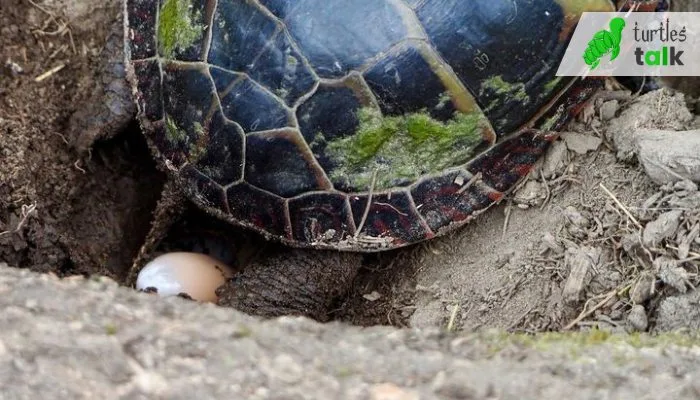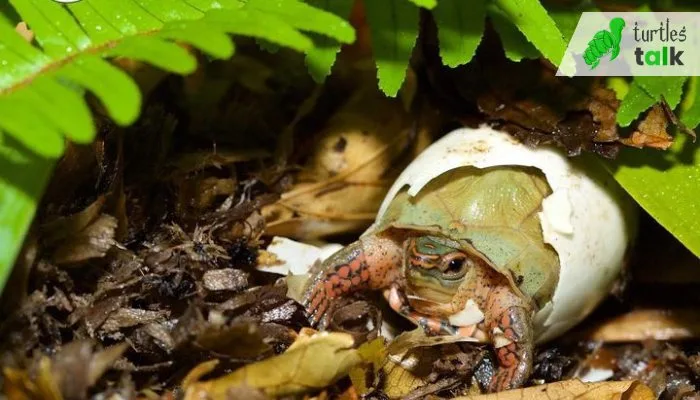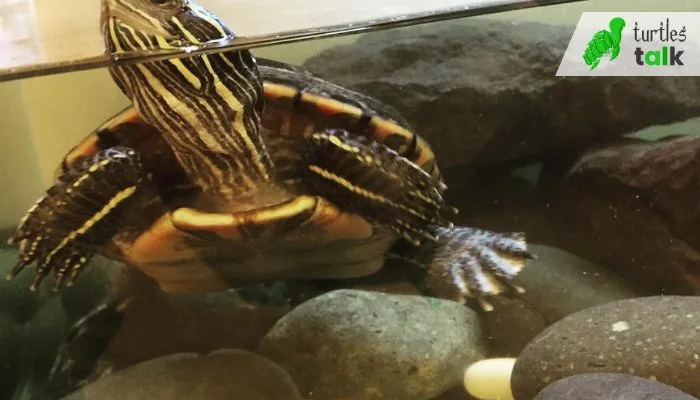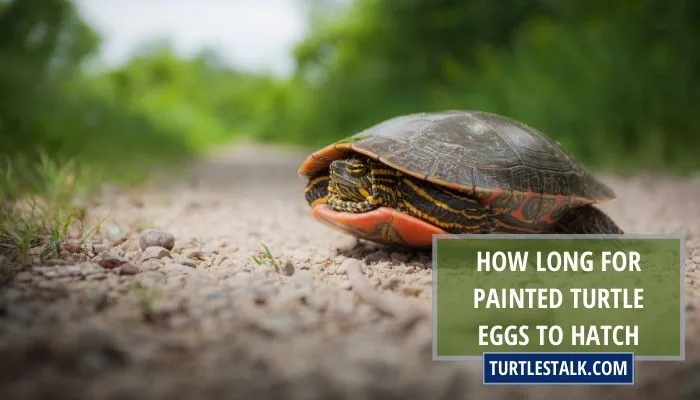How Long Do Painted Turtle Eggs Take To Hatch?
Painted turtles are a species of freshwater turtles that are common in North America. Female painted turtles lay their eggs in the soil during the nesting season, typically between May and July. They dig holes in the ground and lay their eggs inside. Once they lay their eggs, they cover them with soil and leaves to protect them.
The incubation period for painted turtle eggs varies depending on the temperature of the nest. At an average temperature of around 82 degrees Fahrenheit (28 degrees Celsius), painted turtle eggs take about 70 to 80 days to hatch. However, if the temperature is slightly cooler, the eggs may take longer to hatch; if it’s warmer, they may hatch more quickly.
The incubation period also varies based on the amount of oxygen the eggs receive. The temperature of the nest also determines the sex of painted turtles during incubation.
What Is the Average Incubation Period for Painted Turtle Eggs?
The incubation period for painted turtle eggs is the amount of time it takes for the eggs to hatch after they are laid. This period can vary depending on several factors, including the turtle species, the temperature, and the humidity of the environment in which the eggs are laid. For painted turtles, the average incubation period is between 70 and 80 days.

Several factors can affect the incubation period of painted turtle eggs. These include:
Temperature
The temperature of the environment where the eggs are incubated plays a significant role in determining how long the incubation period will be. Warmer temperatures will result in shorter incubation periods, while cooler temperatures will result in longer incubation periods. The optimal temperature for egg hatching is 78-86 degrees Fahrenheit.
Humidity
Another important factor that affects the incubation period of painted turtle eggs is the humidity of the environment. Eggs laid in a nest that is kept at a high humidity will hatch faster than eggs laid in a nest that is kept at low humidity.
This is because high humidity helps keep the eggs moist, which is essential for developing turtles. You should be careful that the humidity shouldn’t be too high, as it can have negative effects.
Egg Size
Larger eggs will typically take longer to hatch than smaller eggs.
Environment
It’s also worth noting that painted turtle eggs in the wild may experience a different incubation period than those in captivity. Nesting sites in nature are often subject to weather changes and predators, which can affect the survival of the eggs.
What Conditions Are Best for Painted Turtle Eggs to Hatch?
Painted turtle eggs are very sensitive to their environment and must be kept in specific conditions to ensure their successful hatching.

Temperature—76-86°F
Temperature is one of the most important factors affecting the incubation of painted turtle eggs. Optimal conditions for hatching are around 76-86 degrees Fahrenheit—lower temperatures can lead to delayed hatching, while higher temperatures can cause premature hatching or poor body condition in the hatchlings.
Humidity—50-60%
Humidity is another important factor for successful egg incubation. The ideal humidity level for hatchling development is around 50-60 percent. Too much humidity can lead to fungal infections, while too little humidity can cause dehydration and compromised hatchling vitality.
Oxygen—Regularly Stirred
Oxygen levels in the incubation environment can also play a role in successful painted turtle egg development. It’s important to have an adequately aerated incubation medium—regularly stirring the eggs and ensuring that the water depth is not too shallow to allow for adequate oxygenation.
How to Tell if Painted Turtle Eggs Are Fertile?
If you are considering collecting or incubating painted turtle eggs, understanding the signs of fertility can help ensure that the eggs you collect are viable. There are a number of things through which you can tell if the eggs are fertile.
Size and Shape
Fertile eggs are typically larger and more rounded than infertile eggs. If the eggs are smaller and more elongated, they are likely infertile.
Color
Fertile eggs are typically a creamy white color, while infertile eggs may be more yellow or translucent.
Veins
Fertile eggs will have visible veins running through them, which can be seen when holding the egg up to a light. Infertile eggs will not have these veins.
Movement
Fertile eggs will have movement inside, which can be seen by gently shaking the egg. Infertile eggs will not have any movement.
Candling
One of the most accurate ways to determine if an egg is fertile is by candling it. Candling involves holding a light source behind the egg to see inside. A fertile egg will have a dark spot in the center, which is the developing embryo. An infertile egg will be clear or have a small white spot in the center.
Check for Mold Growth
If an egg has been sitting in the nest for too long without getting any air circulation, it’s possible for mold to grow on the shell. This can be a sign that the egg is no longer viable and will not hatch.
How Long Do Turtle Eggs Stay Underground?
Painted turtles lay their eggs underground in late spring or early summer. The gestation period of painted turtle eggs can vary greatly depending on the conditions of the location they are laid. They can remain underground anywhere between 70 and 120 days, with an average of around 80 days.
As temperatures increase, the eggs will begin to hatch until all the eggs are out of the nest. The hatchlings must then make their way out of the nest and up to the surface, where they will spend the remainder of their lives.
In cooler climates, the eggs may take longer to hatch, and the hatchlings may remain in the nest for longer. It is important to note that the ideal soil temperature for painted turtle eggs is between 21 and 27 degrees Celsius.
What Time of Year Do Painted Turtles Hatch?
Painted turtle hatchlings typically begin emerging from their nests between late April and early July, depending on the temperature of their nesting area.
If the weather is hot, the hatchlings have a higher chance of survival and will hatch sooner. On the other hand, if the weather is cold, the hatchlings have a lower chance of survival and will hatch later.
Baby turtles are extremely vulnerable at this stage and are preyed upon by a number of predators, including birds, mammals, snakes, foxes, and even other turtle species. So it’s important to protect the nest during this time properly. Once they have successfully hatched, baby painted turtles are omnivores and will eat mostly insects and small fish.
How Do You Know When a Painted Turtle Egg Is Going to Hatch?
Their eggs typically take between two and three months to hatch. If you are lucky enough to find a nest of turtle eggs, you may be curious to know when they will hatch.
Although there is no foolproof way to predict when a turtle egg will hatch, some indicators can give you a good indication of when to expect the little one to emerge.
Observe the Incubation Period
One way to know when a turtle egg is going to hatch is by observing the incubation period. This is the amount of time it takes a turtle egg to develop. The incubation period can vary depending on the turtle species and the egg’s temperature. In general, the longer the incubation period—the closer the turtle is to hatching.
Listen for the Pipping Sound
Another way to know when a turtle egg is going to hatch is by listening to the “pipping sound.” This cracking noise can be heard inside the egg when it is about to hatch.
Watch for the Signs of Hatching
Finally, another way to know when a turtle egg is going to hatch is by watching for the signs of hatching—such as the appearance of a baby turtle’s head or limbs breaking through the egg’s shell.
Contact a Wildlife Rehabilitator
If you are hoping to hatch turtle eggs yourself, it’s important to remember that the baby turtles will need to be released into the wild—and not kept as pets. If you are planning on releasing baby turtles into the wild—contact a wildlife rehabilitator for advice. They can help you with the proper care and release of baby turtles.
What Age Do Female Painted Turtles Lay Eggs
Painted turtles are typically sexually mature at around 4 to 5 years of age. During the breeding season, which typically takes place in the spring, the male turtle will court the female by making soft chirping noises and swimming around her. If the female is receptive, she will allow the male to mount her and mate.

After mating, the female will lay her eggs in a nest that she digs in the soil. The eggs are typically laid in a clutch of 3 to 12 eggs. It’s important to note that the eggs are not fertilized until they are laid, so separating the males and females is crucial if you don’t want them to breed.
Female painted turtles generally lay their eggs between late April and mid-June. These eggs typically have a 2-3 inches diameter and a deep oval shape. Once the eggs hatch, the baby turtles—or “youth”—have a carapace length of 2 inches. At this stage, they have no teeth and cannot swim in the water but can crawl.
Ways To Incubate Painted Turtle’s Egg
In order to successfully incubate painted turtle eggs, several steps must be followed.
Step 1: Collect the Eggs
Firstly, the eggs should be collected from a nesting female, if possible. It is important to handle the eggs carefully, as rough handling can damage them.
Step 2: Eggs Placement
The eggs should then be placed in an incubation container, such as a plastic tub, filled with a moist substrate like vermiculite or peat moss.
Step 3: Maintain Optimum Temperature
The incubation container should be kept at a temperature of 75-86°F.
Step 4: Monitor Moisture Content
The moisture content of the substrate should be monitored, as it should remain moist but not wet.
Step 5: Regularly Turn the Eggs
The eggs should be turned frequently to redistribute the heat and prevent the development of malformations.
There are several ways to incubate painted turtle eggs, including:
Natural Incubation
This involves burying the eggs in a suitable location and allowing nature to take its course. Wild painted turtles often use this method, but it is not recommended for pet turtle eggs as it is difficult to control the temperature and humidity of the environment.
Artificial Incubation
This involves using an incubator to control the temperature and humidity of the environment. This method is preferred for pet turtle eggs as it provides more control over the incubation process and increases the chances of successful hatching.
Do Painted Turtles Sleep Underwater?
Painted turtles’ underwater sleeping habits uncovered: Painted turtles are known for their unique sleeping habits. Contrary to common belief, these turtles do not sleep underwater. Instead, they surface regularly to breathe. While they can spend prolonged periods in water, they typically find a safe spot to rest on land. This way, they can ensure their safety while getting some well-deserved rest.
Conclusion
The incubation period for painted turtle eggs is an important aspect of their reproduction process. The average incubation period for painted turtle eggs is around 72-80 days, but this can vary depending on factors such as temperature, humidity, egg size, and species.
Incubating painted turtle eggs using an artificial incubator is the preferred method for pet turtle eggs as it provides more control over the incubation process and increases the chances of successful hatching.
We hope this article gave you all the information you needed about painted turtle eggs. Remember, these turtles bury their eggs in the ground and leave them there. So if you come across these eggs, leave them undisturbed. If you do want to raise the eggs, follow the steps in the article to keep them safe and healthy.
Do Painted Turtle Eggs Hatch Faster if the Turtle Grows Quickly?
Painted turtle growth stages directly impact the development of their eggs. However, the speed at which a painted turtle grows does not necessarily affect the hatching time of their eggs. The hatching of painted turtle eggs primarily depends on environmental factors such as temperature, humidity, and nest location.

